One of the reasons that I chose to come to Seville was due to the fact that not only could I study Seville's architecture and art, but I can also experience everything that I learn in person.
Seville has several well-known architectural structures, two of which were constructed during the times that the Moors inhabited the city.
In the 12th century, the Almohads (a group of Moors from North Africa), constructed a mosque accompanied by a minaret, which was a tall building used to call the faithful to prayer and worship several times a day.
While the mosque no longer remains, the minaret still stands today. The base was constructed with stone, and the majority of the tower is made of brick. Originally, at the top of the minaret was a yamur - four golden globes of decreasing size; however, after an earthquake in 1356 destroyed them, a bell tower was placed at the top in 1400.
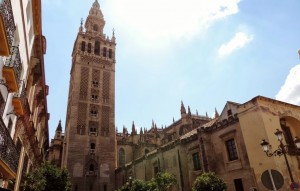
Next to La Giralda, is the Catholic cathedral that was built over the ruins of the Muslim mosque. It was constructed in the 15th century and took over 100 years to complete.
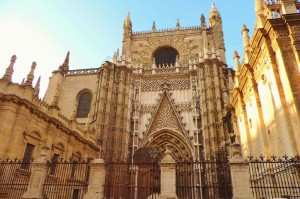
This cathedral is in the Christian Gothic style, which is characterized by height and verticality utilized to create the feeling of reaching into the heavens.
Stained glass windows are also a main characteristic of Gothic style - they are used all around the outside and inside of the cathedral to create a sense that a person is walking into paradise.
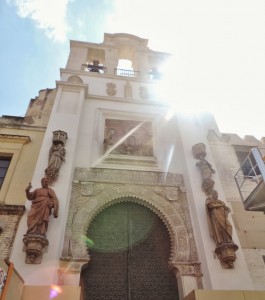
The cathedral has nine doors in total, all of which are constructed in different styles and designs. Aside from the minaret, the door pictured above - Puerta del Perdón - is one of the last remaining parts of the old Muslim mosque. The door is made of wooden panels and decorated with bronze Arabic inscriptions.

Another structure that the Arabs constructed while in Seville was the Torre del Oro - the "Gold Tower." Its name has several potential origins: (1) the tower was close to Casa de La Moneda (the treasury), (2) it stored the treasures brought from the Indies, and/or (3) it was covered in golden tiles that reflected the sun's light. It was built in the 13th century as a watchtower to defend port access of Seville and to serve as a customs point for anything brought from America.
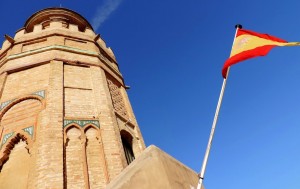
Since the Torre del Oro was constructed as a military watchtower, there were not very many decorations. However, at the very top of the tower, there are a few Islamic decorations. On the far left, we can see a "blind horseshoe arch" (an arch in the shape of a horseshoe that does not serve as a window, archway, or door) as well as a "blind multi-lobed arch" (an arch with several lobules that also does not serve as a window, archway, or door) underneath. At the center of this picture we can see yet another pair of blind horseshoe arches.

One last decoration that is seen at the top of Torre del Oro is "sebka," which is another Islamic decoration of interlacing grids of geometric design.
Another significant structure in Seville is the Alcázar - the royal palace. Originally a Moorish fort in the 10th century, this palace was founded by Abderraman III and extended by his successors. The main style of the Alcázar is Mudéjar - this is a fusion of Christian and Muslim art and architecture.
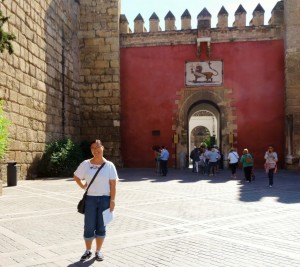
The entrance to the palace is Puerta del León, which means "Lion's gate," and is appropriately called this because there is a tile of a lion (to represent the Kingdom of León).

When you first enter, you encounter three rounded arches - this is the oldest part of the Alcázar - it used to be a part of the Almohad wall.
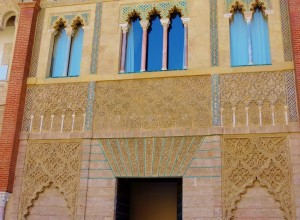
The main attraction of the Alcázar is Pedro I's Palace. Pictured above, we can see intricate designs of sebka again, along with several blind multi-lobed arches. Not pictured is the kufic (Arabic) inscriptions in addition to Gothic lettering.

The first room you come across when you enter is the main courtyard- El Patio de Las Doncellas (The Courtyard of the Maidens). This room was the official center of life - it was where people would wait to see the king.
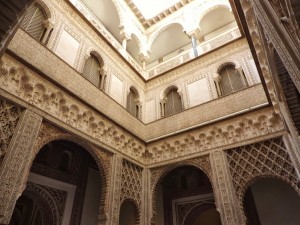
If you continue walking, you will encounter the second courtyard - El Patio de Las Muñecas (The Courtyard of the Dolls). This area was where domestic and private life took place.
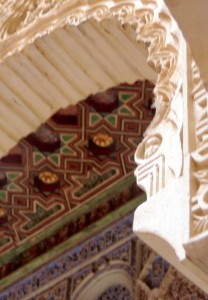
The picture above has one of the two dolls that gives the room its name - legend has it that if you can find the two doll heads, you will get married!
To this day, the palace is still a place that the king and queen of Spain can come to stay when they visit.
The two last structures that I want to share were constructed more recently, but I think they are pretty cool and add to Seville's charm, too.

Plaza de España was built for the 1929 Exposition. A scene from Star Wars Episode II was filmed here.
This is one of my favorite places to visit here in Seville. Pictures don't do it justice; it's even more amazing in person!

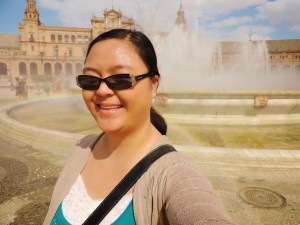
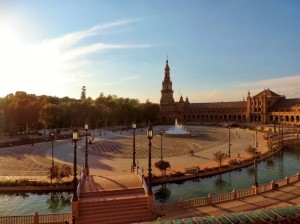
The last structure isMetropol Parasol, more commonly known as Las Setas - the Mushrooms! Construction was only completed a few years ago. Some think that the structure is not well-fitted to the city, but the view from the top is amazing - you can see almost the entire city!
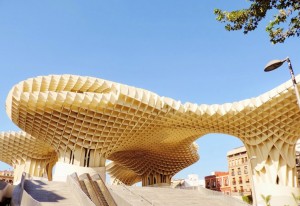
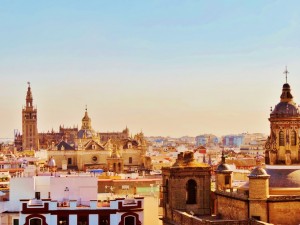
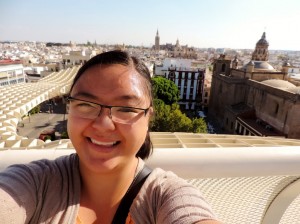
oy Bullock is the Fall 2013 CEA MOJO in Seville, Spain. She is currently a senior at Seattle Pacific University.







